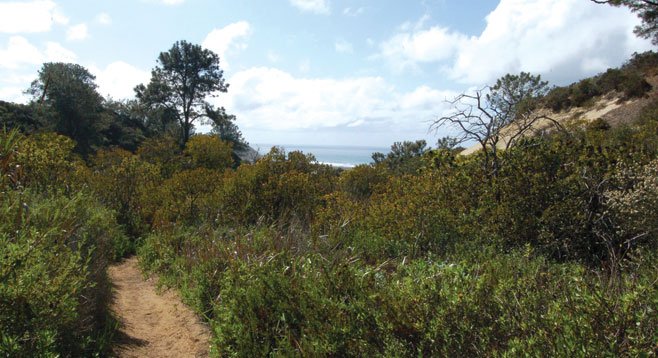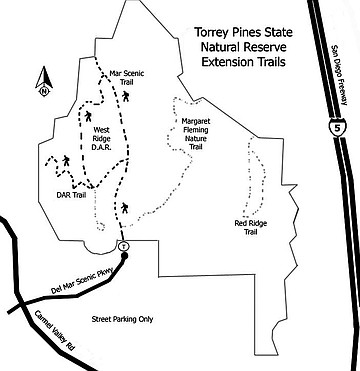 Facebook
Facebook
 X
X
 Instagram
Instagram
 TikTok
TikTok
 Youtube
Youtube

San Diego is a unique and exciting city for many reasons, and the remarkably rare Torrey pine is near the top of that list. Most San Diego residents can probably tell you where to find it, whether or not they realize the tree’s uniqueness. That’s because the well-known Torrey Pines State Natural Reserve between La Jolla and Del Mar offers beautiful ocean vistas, secluded hiking, and, of course, plenty of opportunities to see Torrey pine trees in their natural habitat. Slightly less famous, but equally worthwhile, is the Torrey Pines State Reserve Extension, located just across Los Peñasquitos Lagoon from the main reserve. These less-traveled extension trails offer spectacular pine specimens as well as a rich collection of other coastal sage scrub and chaparral plant life.
While a stroll through either the main reserve or the extension may convince you that the magnificent Torrey pine is relatively abundant, it grows nowhere else in the world except a thin strip of coastline south of Del Mar and a tiny fragment on Santa Rosa Island of the Channel Islands. With only a few thousand individuals in the wild, the Torrey pine is considered rare, threatened, and endangered by the California Native Plant Society. It is a perfect example of why San Diego is globally known as a “biodiversity hotspot,” a region with very high numbers of plant and animal species, particularly endemics, or species that occur nowhere else.
The dry, sandy soils favored by the Torrey pine are also preferred by a variety of other San Diego natives. This coastal sage scrub habitat is rich with wildflowers, various shrubs, and, as the name suggests, sage. Both white and black sage can be found here, as well as the unrelated (except in smell) California or coastal sagebrush. California poppy and sunflower bloom here in late winter/early spring, with many additional wildflowers blooming in the spring months.
Begin the extension trail at the end of Del Mar Scenic Parkway. The trail forks early and turning right will follow the Margaret Fleming Nature Trail to the east side of the wide basin. The half-mile trail climbs sandy bluffs overlooking the entire basin and continues on to Mira Montana Drive. The north and west side of the reserve is explored by turning left at the fork and following the Mar Scenic Trail, which climbs to the other side of the basin and terminates at Mar Scenic Drive. The Daughters of the American Revolution (DAR) Trail can be accessed from this trail, as well. Follow it along a ridge dotted with gnarled Torrey pine trees to access spectacular views of Los Peñasquitos Lagoon and the ocean. A short offshoot trail descends from here into a pleasant, shaded pine grove.

Directions from downtown San Diego: About 20 miles. Allow 25 minutes’ driving time. From I-5, exit west on Carmel Valley Rd. Turn right (north) onto Del Mar Scenic Pkwy. Go to the end of the road and park. No facilities.
Hiking length: 2.0 miles round trip.
Difficulty: Intermediate; up to 200 feet elevation change.
Canyoneers are San Diego Natural History Museum volunteers trained to lead interpretive nature walks that teach appreciation for the great outdoors. For a schedule of free public hikes:
http://www.sdnhm.org/education/naturalists-of-all-ages/canyoneer-hikes/


San Diego is a unique and exciting city for many reasons, and the remarkably rare Torrey pine is near the top of that list. Most San Diego residents can probably tell you where to find it, whether or not they realize the tree’s uniqueness. That’s because the well-known Torrey Pines State Natural Reserve between La Jolla and Del Mar offers beautiful ocean vistas, secluded hiking, and, of course, plenty of opportunities to see Torrey pine trees in their natural habitat. Slightly less famous, but equally worthwhile, is the Torrey Pines State Reserve Extension, located just across Los Peñasquitos Lagoon from the main reserve. These less-traveled extension trails offer spectacular pine specimens as well as a rich collection of other coastal sage scrub and chaparral plant life.
While a stroll through either the main reserve or the extension may convince you that the magnificent Torrey pine is relatively abundant, it grows nowhere else in the world except a thin strip of coastline south of Del Mar and a tiny fragment on Santa Rosa Island of the Channel Islands. With only a few thousand individuals in the wild, the Torrey pine is considered rare, threatened, and endangered by the California Native Plant Society. It is a perfect example of why San Diego is globally known as a “biodiversity hotspot,” a region with very high numbers of plant and animal species, particularly endemics, or species that occur nowhere else.
The dry, sandy soils favored by the Torrey pine are also preferred by a variety of other San Diego natives. This coastal sage scrub habitat is rich with wildflowers, various shrubs, and, as the name suggests, sage. Both white and black sage can be found here, as well as the unrelated (except in smell) California or coastal sagebrush. California poppy and sunflower bloom here in late winter/early spring, with many additional wildflowers blooming in the spring months.
Begin the extension trail at the end of Del Mar Scenic Parkway. The trail forks early and turning right will follow the Margaret Fleming Nature Trail to the east side of the wide basin. The half-mile trail climbs sandy bluffs overlooking the entire basin and continues on to Mira Montana Drive. The north and west side of the reserve is explored by turning left at the fork and following the Mar Scenic Trail, which climbs to the other side of the basin and terminates at Mar Scenic Drive. The Daughters of the American Revolution (DAR) Trail can be accessed from this trail, as well. Follow it along a ridge dotted with gnarled Torrey pine trees to access spectacular views of Los Peñasquitos Lagoon and the ocean. A short offshoot trail descends from here into a pleasant, shaded pine grove.

Directions from downtown San Diego: About 20 miles. Allow 25 minutes’ driving time. From I-5, exit west on Carmel Valley Rd. Turn right (north) onto Del Mar Scenic Pkwy. Go to the end of the road and park. No facilities.
Hiking length: 2.0 miles round trip.
Difficulty: Intermediate; up to 200 feet elevation change.
Canyoneers are San Diego Natural History Museum volunteers trained to lead interpretive nature walks that teach appreciation for the great outdoors. For a schedule of free public hikes:
http://www.sdnhm.org/education/naturalists-of-all-ages/canyoneer-hikes/
Comments